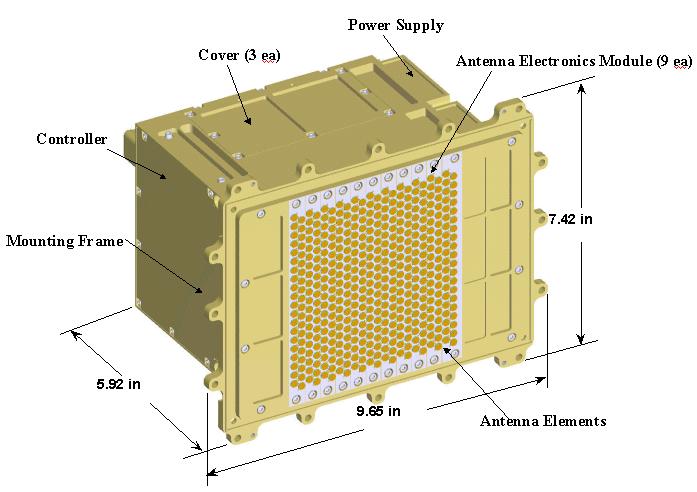Satellite
Orbit and Positioning:
-
There will be three satellites, all in geosynchronous
orbit above Mars' equator. One will be positioned above the longitude of
the landing site, whereas the other two will be 65 degrees on either side.
-
Each satellite, stationed 1.69*107
m above the Martian equator will be able to cover latitudes from 80.4 degrees
South to 80.4 degrees North.
Satellite Specifications:
-
Each satellite will have one X-band and one
Ka-band directional antenna.
-
Each satellite will be stabilized about three
axes, and will weigh approximately 2250 kg.
-
Each satellite will have 2 solar panels (approximately
15 m long each) symmetrically located on either side. These panels will
be capable of generating about 1700 watts for at least 10 years. When on
the dark side of Mars, NiCd batteries will supply power. Internal heaters
combined with thermal coating will provide temperature control.
Antenna Specifications (Ka)
-
Each Ka-Band antenna will weight approximately
5.2 kg.
-
Its dimensions will be as follows: 25.4 cm
x
25.4 cm x 15.2 cm.
-
It will radiate a DC power of about 72 watts.
-
Maximum data transfer rate of 310 Mbps for
a satellite-to-ground link.
-
Maximum data transfer rate of 4 Mbps for a
satellite-to-satellite link.
Antenna Specifications (X)
-
Each X-Band antenna will weight approximately
5.5 kg.
-
It will radiate a maximum DC power of about
160 watts.
-
Maximum data transfer rate of 105 Mbps.
-
Asynchronous data transfer
-
Uses 64 directional elements to form a phased
array.
-
Can be omnidirectional or unidirectional.
-
Dimensions: 28 cm x 33 cm x 7.62
cm.
-
Cost effective
Author: David Broniatowski (sabrevln@mit.edu)
References:
http://eo1.gsfc.nasa.gov/Technology/Documents/XPAADescription.PDFLink
to XPAA Technology Description, courtesy of EO-1 Instruments and Technologies
and NASA
http://jazzman.gsfc.nasa.gov/technology/kaband.htm
Link to Microwave Systems
Branch Advanced Technology Programs, run by NASA
http://eo1.gsfc.nasa.gov/Technology/XPAAGallery.html
Link to EO-1 Instruments
and Technologies: XPAA group, also run by NASA |

http://jazzman.gsfc.nasa.gov/technology/kaband.htm
Link to Microwave Systems
Branch Advanced Technology Programs, run by NASA
 
http://eo1.gsfc.nasa.gov/Technology/XPAAGallery.html
Link to EO-1 Instruments
and Technologies: XPAA group, also run by NASA
|


